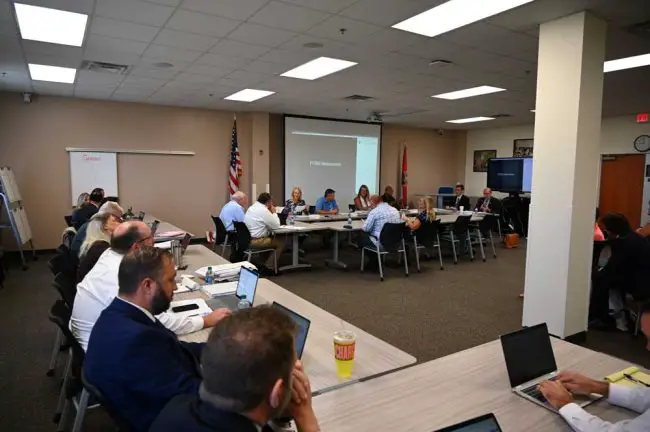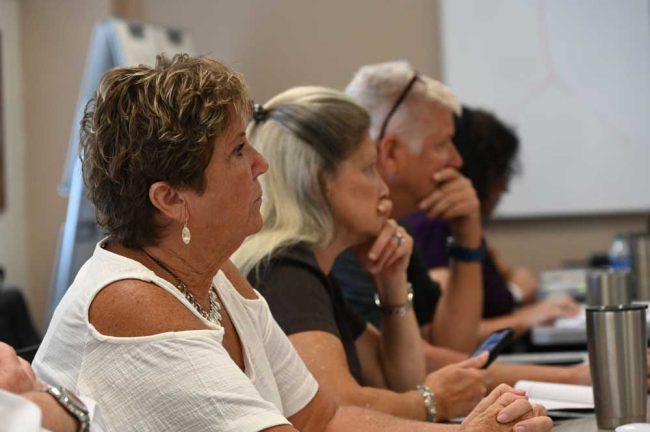
Note: this is the first of two articles on today’s ILA meeting. See the second part here.
For 110 minutes this morning, elected officials from the school board, Palm Coast, Bunnell, Flagler Beach and county governments took turns talking about and around a months-long impasse that has kept all the sides from agreeing to a new way of financing school construction when schools are overcrowded.
A solution is essential. Without it, more than a dozen planned and ongoing large developments could come to a halt.
It took School Board member Trevor Tucker 90 seconds to break the impasse: Major builders would be required to pay a 30 percent share of school construction dues up front, 30 percent at the development’s 21-month mark, and 30 percent at the 42-month mark. The remaining 10 percent would be paid through school impact fees. (Home builders who put up a few houses at a time are not affected.)
A working group will now draft the proposal into a new joint agreement between the five governments (what’s referred to as an Inter-Local Agreement, or ILA), the oversight committee that met today will meet again to review it on Sep. 8. The proposal will then be circulated among the five elected bodies for approval, and by Nov. 9 (a new deadline, pushed back from Sept. 1 with the agreement of a kicking-and-screaming Dave Sullivan, the county commissioner), a new ILA should be in place.
The County Commission decided to tear up the the existing ILA, in place since 2008, because the majority of its members thought builders and developers were too unfairly inconvenienced by the up-front fees they had to pay.
The details–even the method of financing under discussion by the officials–are not anything the public at large is interested in. They’re intricate, arcane, and at the most basic level, affect an infinitesimal group of two special interests: developers and builders. The financing formulas in question affect those two groups when they build new homes, and affects them exclusively.
But builders and developers wield disproportionate political influence locally, especially with the County Commission, which provoked the conflict the governments are now trying to resolve. Beyond those two groups, the financing formulas have no bearing on residents. They don’t even affect homebuyers, who will be paying the same price regardless. That’s why the many meetings about the issue have drawn no audience other than government staffers, lawyers, and people representing builders and developers.
But the consequences of what the financing formulas address do potentially affect thousands of students and their families–whether they’re existing homeowners, apartment dwellers, or future homeowners. The reason: those formulas set the method through which the school district collect money from developers to defray the cost of new schools compelled by new development. (More homes generally, but not always, means more students.)
Ultimately, the school board will collect so-called school impact fees for most new homes built. But those impact fees are paid only when a building permit is issued. It doesn’t give the school district enough time to plan ahead for new space for students. So there is such a thing as “proportionate share mitigation” payments. When schools are already at capacity, as middle and high schools are now, that’s the money developers must pay well before their impact fees are due, so the school district can start its own process of building new schools.

“We have to have the schools ready for when the students come. So if you’re looking at CO’s [certificates of occupancy], then you’re looking at well, the schools need to be built by that time,” Patty Bott, the district’s chief planner, said. “It’s all about planning, we need the funds earlier, most of the state actually in proportionate share mitigation, including our neighbors, require a 30 percent payment up front. What we’re doing is unusual, in trying to work with the development community, because we do want new development.”
The builders and developers owe that money anyway, in the form of impact fees. All the proportionate share mitigation formula does is move up the timing of that payment. Once paid, the builders get a credit for impact fees owed. The net result is that the final cost of the home as the homebuyer sees it is not affected–only the builder’s cash flow is. To the chagrin of the school board, much of the debate of the past year has revolved around accommodating builders’ cash flow ahead of accommodating the district’s school-construction planning. That debate has necessitated the many meetings of the ILA working group and its oversight committee made up of elected officials.
The issue appeared resolved when the working group last met and Palm Coast staffers proposed a 30-30-30 split of up-front money over 48 months. District staffers appeared to agree. The breakthrough was illusory. Soon after that meeting the district walked back its agreement by saying that stretching the timing to 48 months would add millions in financing cost to the district’s bonds.
“So 36 months is the best use of taxpayer dollars to collect more funds up front and limit bonding as much as possible,” Bott said, summing up the key difference between the district’s position and the Palm Coast position at the beginning of the meeting: one year. Palm Coast was proposing to stretch up-front payments over 48 months. The district wanted that over three years, or 36 months.
The extra year would cost $23 million more in financing, according to Bott, assuming the district was to build its middle and high school at the currently scheduled pace. Several officials around the table, including palm Coast’s, find the district’s construction projections very hard to swallow. So far, Palm Coast, not the district, has data on its side.
“Both options that you’re seeing today are financially feasible, but not necessarily responsible use of public money,” Bott said.
The district had marshaled the help of a bond expert, Laura Howe, of PFM Financial Advisors, to explain what the district could and could not do in its bond financing. So much of the discussion in the first part of the meeting revolved around that: how would the district’s bonds be secured? How do impact fees figure into the equation?
Impact fees may be used to pay debt, but that revenue isn’t used to secure the debt. Property tax revenue does that, in essence shifting some of the financial burden from future residents (who pay impact fees) to existing residents (who have already paid their impact fees, which are figures into the price of new homes, and are presumably being double-taxed).
The school district has a portion of its property tax ($1.5 per $1,000 in taxable value on all local properties) reserved for capital needs, including repairs, buses and new construction. But it doesn’t generate enough revenue to account for all needed construction. Nevertheless, because that revenue is more stable than impact fee revenue, it’s used to secure bonding used to finance school construction. Impact fee revenue itself may not be used to secure a bond–only to pay down a bond, Howe said.
“Obviously the more cash that can be put up, the less interest expense there is moving forward with more capacity for other needs that may come up down the road for the district,” Howe said. (That capital fund isn’t used only for new buildings, but for a long list of recurring maintenance needs that adds up to millions in expenses every year.) “If you’re paying for one project with 100 percent cash or 50 percent of cash, that doesn’t set a precedent for down the road.”
All of that became a moot point once the matter was distilled to its essentials: the difference between the district and Palm Coast’s proposals, which Tucker, reigning champion of brevity among elected officials, broke the impasse. Tucker is less known for his incisiveness only because he exercises it rarely. But when he does, it almost always has a decisive impact because it is usually grounded in pragmatism and data. He summed up today’s proposal in three words: “Split the difference.”

The actual resolution of the issue now hinges on the various governments accepting the Tucker compromise–assuming the County Commission agrees to extend the scrapping of the existing ILA to Nov. 9, instead of Sept. 1. That’s a big if, even with Sullivan agreeing to the extension. Commissioner Andy Dance was also at the table today, but he is the commission’s friendliest voice for the school board, having served 12 years on the school board previously. The wild card, as always, is Commissioner Joe Mullins, who is largely–and arbitrarily–responsible for the Sept. 1 deadline and the scrapping of the ILA (he is the commission’s friendliest voice for developers and builders). He was not in the room today. The commission meets on Aug. 15. Other governments are expected to approve both the compromise.
If the county balks, then the entire county and the cities will find themselves without a legally-required ILA in place on Sept. 1. Palm Coast Attorney Neysa Borkert cautioned everyone around the table today: “The district wouldn’t be able to enter into any [proportionate] share agreements or capacity reservations, because there’s no method to do so.” In other words, major developments would come to a halt, and there’s nothing the county could do about it. That includes Grand Reserve in Bunnell, and many more on Bott’s desk right now.
“I have 18 concurrency reservation applications waiting to go through prop share,” Bott said. “Those 18 would have to stop, they’d be affected, and they’re in various stages of negotiations.”
That gives the district a powerful trump card against agreeing to the shorter timelines, but it did not exercise it. “It always seems like the school board is making the concessions in this process,” Dance said. “Just the acknowledgement if we can get to this point and move forward, forward future collaboration is what we have to focus on to stop some of the strife and battles and moving forward on a unified front to make our schools adequately funded.”
“Always the statesman,” School Board member Colleen Conklin said of Dance (a statement whose flip-side implied a lack of statesmanship on the commission).
Palm Coast Mayor David Alfin, who chairs the oversight committee, acknowledged the sentiment, and the meeting adjourned.
![]()





























Dennis C Rathsam says
God Bless You Mr Tucker…. I think you would make a great mayor!
ULTRA MAGA says
Another Very Important Meeting that RINO Mullins MISSED! Did his Developer Bosses order him NOT to attend? Joe has been a ‘CONFLICT of INTEREST’ Guy since he became a commissioner! The Florida AG should be investigating him, his attorney, and the developers( the DOJ should also start an investigation )! I received his campaign post card today; I had to look twice since he looks so much like Adam Schiff! The BULLSHIT he is promoting in INSANE! WAKE UP Flagler County Voters!
Kirk2099 says
agreed hard to do your Job when you are never there